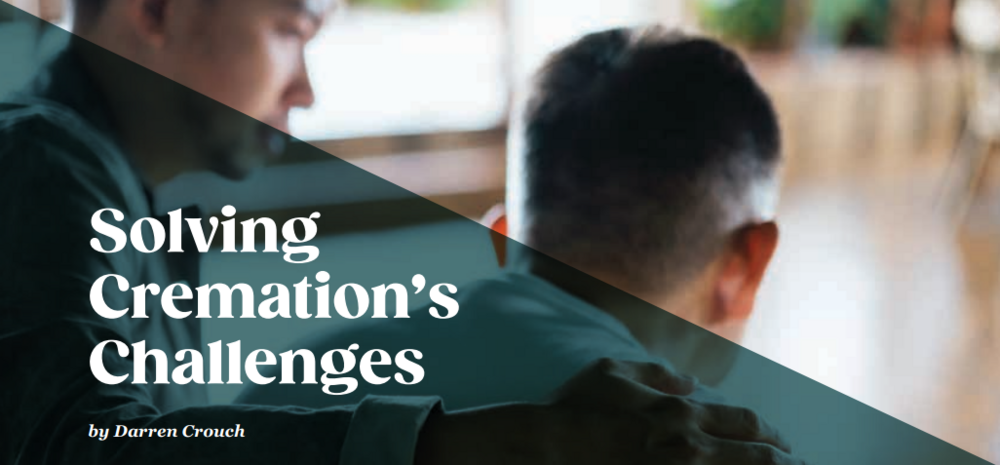(404) 312-6640
Solving Cremation’s Challenges
Cremation poses several challenges when it comes to conveying and delivering value. With burial, there are multiple tangible products that a price tag can easily be attached to. Think embalming, clothing, caskets, and services not to mention all of the cemetery products. However, with cremation, many of those products and services are not required or selected since “they are just going to be burned” or “we are having a direct cremation”.
Given the above, how do funeral homes avoid the race to the bottom and not have to rely purely on volume to replace dwindling revenues per call? The easiest way to accomplish this is by providing value that families appreciate and are willing to pay for. So often, funeral professionals provide products and services that they would like to sell versus paying any real attention to what data indicates families want and are willing to pay for.
To provide some historical context, the industry arrived in this predicament as a result of its poor decision-making. As cremation rates were increasing and families were clearly appreciating the simplicity and affordability, many funeral professionals were looking for ways to avoid having to offer it, or how to dissuade its selection. The minority saw the opportunity and found ways to offer it to families. This was often in the form of minimal services in bare-bones facilities designed for cost-effectiveness and volume. Think industrial metal building with parking for a van, a cooler, a retort, and cardboard box storage.
By stripping much of the value and dignity, funeral professionals educated families early on that cremation was simple, less expensive, and did not need elaborate products or services. These families just got used to it and learned that’s all they needed. Even families with significant disposable income like business owners, doctors lawyers, etc. spend very little on the cremation itself, but much more on the celebration afterward.
One way to deliver value is to understand what families want and base product and service decisions on that knowledge. By paying close attention to the many consumer surveys that are conducted every few years, whether it’s the NFDA’s Consumer Preferences Survey or others, they gather information on what families want and value.
In these surveys, as they relate to cremation, affordability, environmental concerns and a desire to scatter are consistently areas that families express interest in. They often perceive cremation to be greener because it consumes fewer resources, despite the fossil fuel required for the cremation itself. This provides an opportunity to include greener options including cremation containers, biodegradable urns, and urns designed for scattering.
When looking at the products most commonly associated with cremation, basic cardboard for the actual cremation and black plastic boxes for the cremated remains are prevalent. Despite a pretty good margin on these products when they are sold, a lot of money is being left on the table. This is simply because you can only charge so much for these products before families start asking how it is possible to charge $100 or $200 for a basic cardboard box that you might find a refrigerator in or $49 for a black plastic box for the remains.
The industry knows that these products are a problem and has tried to find other alternatives. The challenge has always been, how to provide something of value that families are prepared to pay for, knowing that it will be burned (in the case of cremation containers). The answer is a product that is produced from sustainable and renewable resources, has a social consciousness, burns cleanly, is dignified, and yet is still affordable.
In late 2019, a progressive and large firm in Albuquerque, New Mexico decided to remove cardboard cremation containers and replace them with a bamboo container. The answer to the question I know you are asking is, yes families are prepared to pay significantly more for them. The reason is that families are willing to pay for a product that has tangible value, value that they appreciate, understand, and are familiar with.
The price of the minimum cremation container went from $195 to $595 but families rarely asked about the price and when they did, the staff was able to answer that they “have moved away from cardboard to a simple bamboo container made from renewable resources that is cleaner burning”. Families appreciated the simplicity as the bamboo product did not have handles, a pillow, or a lining and were willing to pay as it was clearly a product that had been thoughtfully created for this purpose.
So how was this done? Firstly, the merchandising displays and processes were changed. Mounted product photos were produced that showed the Simple Bamboo Container and matched the product photos of the other higher-end products being offered. The selection was simplified by removing the many choices of other cardboard-based products that cluttered the lower-priced end of the selection. This made it easier for families to buy up and get into ceremonial rentals or simple wood caskets that were usually priced well over $1000.
Secondly, all of the staff were trained on the product. How and where it is made? How to convey the value and defend the price when needed? How to handle it during transfer from the funeral home to the crematory and sharing laboratory burn test results? The response from families at this funeral home was overwhelmingly positive. They liked the fact that it came from a renewable resource and was cleaner burning, and there was no price sensitivity even though Albuquerque is not a particularly eco-conscious community.
The results of this change were impressive. Looking back over 2 years, the average spend per cremation family increased by 30%, cremation container revenues doubled, and customer satisfaction increased. Families were more engaged and purchasing other products, versus just choosing minimum options. In addition, there would have been cost savings as laboratory tests reveal that bamboo burns at a lower temperature and cremates more completely leaving purer remains that require less processing.
The container itself also has impressive credentials. Despite being made overseas and imported into the United States, since it ships flat-packed and is assembled at the funeral home or crematory it has a small carbon footprint. Not to mention that Passages pays for carbon offsets when importing any container from overseas. Bamboo is a renewable resource since it grows very fast and does not require a lot of space or chemical fertilizers. This particular bamboo is also processed and produced into cremation containers close to where it grows. In addition, the production teams work with local farmers to harvest this bamboo that generally grows, un-tended between fields of other cultivated crops. This makes it a good source of additional income for farmers.
There is also a bigger story behind what families can get. The bamboo container is certified Fair Trade and the ten principles primarily pertain to the social impact that the crafting of the product plays. It also brings more consistent employment in a geographic area that is economically depressed and the factory provides staff with life and manufacturing skills. The production facility has staff that help employees with issues like domestic abuse and predatory lending that your typical HR department would not assist with.
After the cremation of the body, the cremated remains need to be placed into an urn of some sort. So often the selection available to the family is outdated and not in line with what consumer data tells us. As mentioned at the start of this article, surveys consistently show that families overwhelmingly intend to scatter cremated remains. Since this is the case, it is important to offer a representative selection of scattering and biodegradable urns, since data consistently shows that over 40% of families intend to scatter. If you don’t have a selection of products suitable for scattering, families will often opt for the least expensive option.
By making business decisions based on sound consumer data, funeral homes can align more closely with the desires of families. This makes it easier to create value and drive revenues by providing products and services that resonate with families. Have the conversations that they want to have and be the experts at crafting cremation experiences that both honor and celebrate the deceased in a meaningful and sustainable way. These will often be in unique locations with unique sustainable products that funeral professionals are less comfortable with. Trust the process… there is no doubt that families want and will pay for products and services that seem and feel new or foreign to them.






Comments